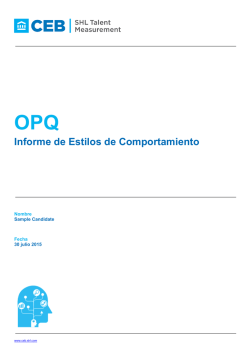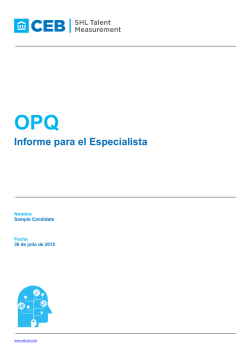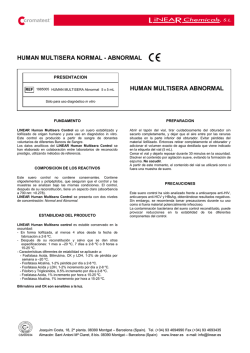
EAB Muestras de elección para su analisis
EAB Muestras de elección para su analisis Fases: Preanalítica Analítica Postanalitica Errores preanaliticos 75% de los errores en un laboratorio 4 etapas: 1) Preparación del paciente 2) Toma de muestra 3) Manejo de la muestra 4) Conservación y transporte Las cuatro principales causas de los errores preanaliticos son 1) Anticoagulantes 2) Toma de muestra desde cateteres 3) Hemolisis 4) Conservacion 2 Anticoagulante de elección: HEPARINA. Origen: 1916, mastocitos y basofilos en higado Estructura: Mucopolisacárido ( glycosaminoglicanos), compuesto por secuencias repetidas de disacáridos, no ramificados y de extensión variable, con una alta proporción de disacáridos sulfatados. PM: Variable, desde 3 a 30 KDa. Mecanismo : Potencia la acción de la Antitrombina III La acción de la heparina es tanto en vivo como in vitro. 3 Anticoagulation • Tipos de Heparina disponibles -Liquid non-balanced heparin -Dry non-balanced heparin -Dry Ca2+-balanced heparin -Dry electrolyte-balanced heparin (Na+, K+, Ca2+) -Dedicated blood gas syringes and capillary tubes are coated with heparin to prevent coagulation in the sampler and inside the blood gas analyzer Other anticoagulants, e.g. citrate and Why is there no alternative to EDTA are both slightly acidic. heparin when measuring blood There is a risk of pH being falsely lowered gases? by this effect. 4 Unidades. UI/ml Concentración usada para anticoagular 10 a 15 UI/ml sangre ES SUFICIENTE? 3 PROBLEMAS: DILUCIÓN, ADICION, QUELACION Liquid heparin - dilution • El uso de Heparina liquida como anticoagulante causa dilución de la muestra • Esto afecta a la medición de los parámetros en forma significativa. • Na+, cK+ and especially cCa2+ will bind to heparin and be biased even further • Co-oximetry : sus parametros dados como fracciones no se veran afectados, pero si la Hb Total 6 DILUCIÓN ADICIÓN. Cual es la composición de la solución de heparina? CUAL ES EL “MEDIO INTERNO” DE LA HEPARINA LIQUIDA ? Concentración de las presentaciones comercial de Heparina Sodica. ( 5000 UI/ml) pH 6, 70 – 6,40 pCO2. < 4 mm HG pO2. 160 mmHG Na: 160 - 170 meq/l Cl : 96 -100 meq/l CUAL ES LA SOLUCION: HEPARINAS LITIO, LIOFILIZADAS, ELECTROLITICAMENTE BALANCEADA 8 QUELACION • Always use electrolyte- balanced heparin when measuring electrolytes in combination with blood gases • Non-balanced heparin binds positive ions such as Ca2+, K+ and Na+ • The binding effect and the resulting inaccuracy of results are especially significant for cCa2+ 9 Union del Calcio Iónico • La muestra tiene un True value 1.15 mmol/L Measured value 1.08 mmol/L verdadero valor de cCa2+ de 1.15 mmol/L • Si uso 50 I.U. heparina liofilizada no balanceada por mL de plasma, obtengo un valor 1.08 mmol/L • El delta, de 0.07 mmol/L corresponde al 50 % del rango del valor de referencia del cCa2+ (1.15 - 1.29 mmol/L) Consequence of using non-balanced heparin: The cCa2+ result is below the reference range. There is a risk of misdiagnosing the patient. 10 Electrolyte-balanced heparin • Electrolyte balanced heparin significantly reduces the binding effect and the resulting inaccuracy • Electrolytes are added to the heparin during manufacturing, so that the activity of the electrolytes in the heparin is the same as in normal plasma 11 Toma desde una via • Las solucines de lavado usadas en una via deben removerse por completo antes de tomar una muestra • Se recomienda remover al menos dos veces el espacio muerto de la via 12 Inadequate removal of flush solutions – an example • Sample B and A are both a-line samples taken from the same patient immediately after each other • Before taking sample B only 1 mL of saline solution was removed the tubing, however, looked red • Before taking sample A saline solution was removed as recommended Sample A ctHb cGlu cK+ cNa+ cCa2+ cClpH pCO2 pO2 6.2 mmol/L 9.6 mmol/L 3.8 mmol/L 130 mmol/L 1.00 mmol/L 101 mmol/L 7.271 50.5 mmHg / 6.7 kPa 116.7 mmHg / 15.56 kPa Sample B ctHb cGlu cK+ cNa+ cCa2+ cClpH pCO2 pO2 4.6 mmol/L 6.9 mmol/L 2.5 mmol/L 137 mmol/L 0.61 mmol/L 113 mmol/L 7.275 35.9 mmHg / 4.8 kPa 129.3 mmHg / 17.2 kPa Consequences of removing insufficient flush volume: All parameters are diluted, except the saline components (Na+ and Cl-) which are increased. 13 BURBUJAS • Una vez tomada la muestra, se debe remover lo mas rapido posible toda burbuja de aire de la jeringa, sobre todo: -Antes de mezclar la jeringa con la heparina -Antes de refrigerar la muestra • Aun las burbujas mas chicas deben ser eliminadas. • Se estima que cualqueir burbuja de mas del 1% del volumen de la muestra tomadas, puede influir de manera importante en el resultado 14 Effect of air bubbles - an example • Sample A and B were taken from the same patient immediately after each other • Sample A without air bubbles was analyzed immediately after collection • 100 µL air was added to sample B (1 mL). It was stored cold (0-4 °C) for 30 minutes and mixed for 3 minutes before sample analysis Sample A pO2 71.0 mmHg / 9.5 kPa Sample B pO2 88.3 mmHg / 11.8 kPa (air bubble pO2150 mmHg / 20 kPa) Consequence of air in sample: pO2 is positively biased due to the air bubble. In this situation, the biased patient result is within normal ranges for pO2 (83-108 mmHg or 11.114.4 kPa) 15 Hemolysis • Hemolysis may lead to cCa2+ (c)= 1 µmol/L cK+(c) = 145 mmol/L significantly increased plasma cK+ values due to the large difference in the K+ concentration inside and outside the blood • Extensive hemolysis may also result in a significant fall in cCa2+ • Hemolysis may, for instance, occur due to - Too narrow needle diameter cCa2+(P) = 1.2 mmol/L cK+(P) = 4 mmol/L - Vigorous rubbing or squeezing of the skin during capillary sampling - Vigorous mixing of the sample - Cooling down the sample below 0 °C 16 HEMOLISIS Hemolysis - an example • Sample A and B were taken from the same patient immediately after each other • Sample A was analyzed immediately after collection • Sample B was stored on ice for 25 minutes and mixed for 5 minutes before sample analysis Sample A cK+ mmol/L cCa2+ mmol/L 3.3 1.08 Sample B cK+ 43.6 mmol/L cCa2+ 0.33 mmol/L • Extensive hemolysis as the above will often be detected • A smaller degree of hemolysis and the resulting inaccuracy may often not be detected 18 Inadequate mixing of sample before analysis • How fast does a whole-blood sample sediment? - Within 30 minutes? - Within 10 minutes? • There is no universal answer • Sedimentation time is individual and depends on age and immunological condition • A fully sedimented sample is easy to detect, but can you spot a sample that is only 5 % sedimented? Consequence of inadequate mixing before analysis: ctHb will be biased, but the actual bias will depend on which portion of the sample 19 Inadequate mixing of sample before analysis • If the sample is visibly sedimented, it needs mixing for several minutes. Follow the mixing procedures of your unit. • The cell stacks are most effectively disturbed when the syringe is rotated through two axes, i.e. -Rolling it between the hands AND -Inverting it vertically 20 Insufficient mixing with heparin • Insufficient mixing can cause coagulation of the blood - Inside the syringe and inside the blood gas analyzer • A coagulated blood sample is not homogenous and the results are not reliable • It is recommended to mix the blood sample in two dimensions - Roll it between your palms AND - invert it vertically 21 Conservacion. Recomendaciones General storage recommendation Medir la muestra inmediatamente Si la conservacion es inevitable: Analizar la muestra dentro de los 30 minutos Para muestras con valores altos de pO2, Leucocitos o plaquetas: Medir dentro de los primeros 5 minutos Para estudios especiales: ( shunt) Analyze within 5 minutes Si se esta seguro que la muestra se va a demorar mas de 30 minutos, es recomendable sacar con jeringa de vidrio y conservar en agua(/ hielo • El tiempo de transporte y conservacion debe ser el minimo posible -Volatile nature of gases -El metabolismo en la sangre continua • Para mediciones de GLU/LAC, saber que mas de 30 minutos de demora puede conducir a valores no reales • No conservar muestras en frio si estan sacadas en jeringas de plastico 22 Continued cellular metabolism in the sample pO2 Disminuye ( Por consumo) pCO2 Aumenta Se sigue produciendo pH Disminuye: Por aumento de la CO2 y la glycolisis cCa2+ Aumenta El medio acido creciente lo libera de las proteinas cGlu Disminuye cLac Aumenta: Por la glicólisis 23 Slowing down the metabolism pO2 • Blood gas samples in glass Time 0-4 C 25 C samplers can be cooled • Storing the sample at a lower temperature (0-4 °C) will slow down the metabolism by at least a factor of 10 [NCCLS] • Cool samples in an ice slurry or other suitable coolant • Never store the samples directly on ice as this causes hemolysis of the blood cells 24 MUCHAS GRACIAS 25
© Copyright 2024


